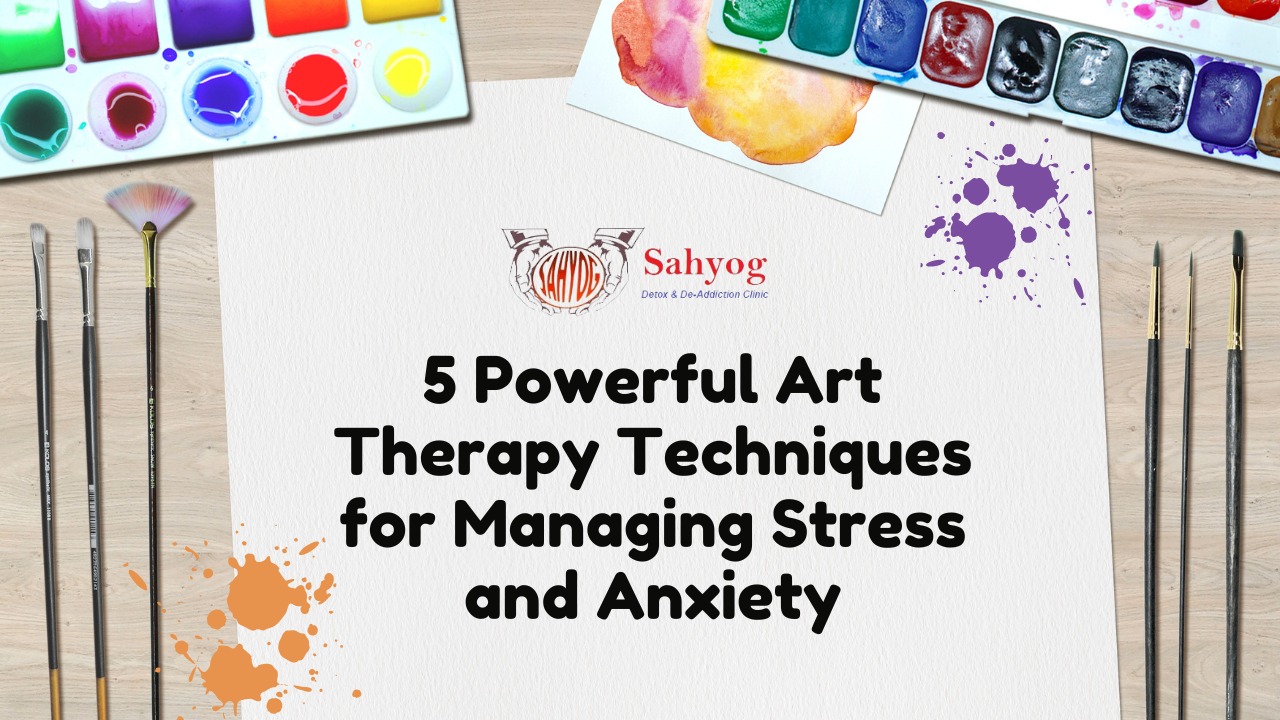5 Powerful Art Therapy Techniques for Managing Stress and Anxiety
In today’s fast-paced world, stress and tension have come to be increasingly typical. The needs of modern life, which includes work obligations, personal relationships, and societal pressures, can take a toll on our mental well-being. While traditional forms of therapy are effective, an alternative approach that has gained recognition is art therapy. Art therapy harnesses the strength of creative expression to promote recovery and self-discovery. This article will delve deeper into five powerful art therapy techniques that can help individuals effectively manage stress and anxiety. By providing a healthy outlet for emotional release and self-reflection, these techniques empower individuals to take control of their mental well-being.
Mindful Coloring:
Mindful coloring is a simple yet effective art therapy technique that promotes relaxation and focus. The act of coloring intricate patterns or mandalas can divert attention away from racing thoughts and bring a sense of calmness. Engaging in mindful coloring encourages mindfulness, enabling individuals to stay present in the moment and find respite from stress and anxiety.
Mindful coloring involves carefully selecting colors, paying attention to the movement of the hand, and focusing on the sensations and rhythm of the coloring process.
By immersing themselves in the act of coloring, individuals can achieve a state of flow, where worries and stressors fade into the background. This meditative practice stimulates the release of endorphins, natural mood-boosting chemicals in the brain, promoting a sense of well-being. Mindful coloring can also serve as a form of self-care, allowing individuals to carve out dedicated time for relaxation and personal rejuvenation.
Expressive Painting:
Expressive painting allows individuals to channel their emotions onto a canvas. This technique encourages the use of vibrant colors, bold brushstrokes, and abstract imagery to express feelings that may be difficult to articulate verbally. Through painting, individuals can externalize their stress and anxiety, gaining a sense of release and relief.
Expressive painting offers a non-judgmental space where individuals can freely express their emotions without the constraints of words or societal expectations. The act of applying paint to a canvas becomes a symbolic act of letting go, allowing individuals to confront their emotions head-on and gain a new perspective. The creative process itself can be therapeutic, providing a safe space for self-expression and exploration of inner thoughts and emotions. As individuals witness their emotions manifest on the canvas, they may experience a sense of validation and catharsis, leading to a greater sense of emotional well-being.
Collage Therapy:
Collage therapy involves creating visual compositions by combining different materials such as cut-out images, photographs, magazine clippings, and various textures. This technique allows individuals to construct narratives or representations of their feelings and experiences. Collage therapy can be particularly useful for those who struggle with verbal communication, as it offers a nonverbal means of expressing complex emotions.
Collage therapy encourages individuals to gather materials that resonate with their emotions and arrange them in a way that feels meaningful. As they create their collage, they can explore the connections between the images, textures, and colors, uncovering insights into their emotional landscape. The act of arranging and gluing materials can provide a sense of control and organization, aiding in the processing of stress and anxiety. Collage therapy can also foster a sense of empowerment, as individuals take ownership of their emotions and actively engage in the creative process.
Journaling with Art:
Combining art with journaling can be a powerful tool for managing stress and anxiety. By integrating written words with visual elements such as sketches, doodles, or collages, individuals can engage in a holistic form of self-reflection. Journaling allows for the exploration of thoughts, emotions, and triggers, while art provides a visual representation of these inner experiences. This technique promotes self-awareness, emotional expression, and serves as a valuable outlet for releasing pent-up stress and anxiety. Through the act of journaling with art, individuals can cultivate a deeper understanding of their emotions, identify patterns and triggers, and develop healthy coping strategies.
Clay Sculpting:
Working with clay offers a tactile and sensory experience that can be highly therapeutic for managing stress and anxiety. The malleability of clay allows individuals to physically shape and mold their emotions. Sculpting can provide a sense of control and empowerment, as individuals transform shapeless clay into tangible forms. The process of sculpting engages both the mind and body, fostering relaxation, concentration, and a meditative state. Through clay sculpting, individuals can explore their emotions in a three-dimensional way, giving them the opportunity to externalize their stress and anxiety and gain a deeper understanding of their inner world.
Conclusion
Art therapy techniques provide individuals with powerful tools to manage stress and anxiety effectively. By engaging in mindful coloring, expressive painting, collage therapy, journaling with art, and clay sculpting, individuals can tap into their creative potential and find relief from the pressures of daily life. These techniques offer a secure space for emotional release, self-reflection, and self-discovery. Art therapy now not only offers a brief reprieve from stress and anxiety but additionally equips people with treasured coping capabilities that may be applied past the therapeutic setting. By embracing artwork as a form of therapy, people can empower themselves to foster their mental well-being and live greater balanced and fulfilling lives.
Frequently Asked Questions (FAQS):
1.What is artwork therapy?
Art therapy is a form of therapy that makes use of creative procedures and artistic expression to enhance mental health and well-being. It harnesses the energy of artwork to promote self-expression, emotional release, and self-discovery.
2. How does art therapy help manage stress and anxiety?
Art therapy provides a healthy outlet for emotional release and self-reflection. Engaging in art activities allows individuals to express and externalize their stress and anxiety, fostering relaxation, mindfulness, and a sense of control.
3. Do I need to be an artist to benefit from art therapy?
No, artistic skills or talent are not required for art therapy. The focus is on the process of creating and expressing oneself rather than on the final product. Everyone can benefit from art therapy, regardless of their artistic abilities.
4. Can art therapy be used as a standalone treatment for stress and anxiety?
Art therapy can be used as a standalone remedy or alongside with different therapeutic processes, depending on individual needs. It can be an effective tool for coping with stress and anxiety, but it’s far more critical to seek advice from a qualified art therapist or mental health expert for personalized guidance.
5. Are there any particular artwork materials required for artwork remedy?
Art remedy can involve an extensive range of materials, which include colored pencils, paints, clay, university materials, and more. The choice of materials depends on personal preference and the goals of the therapy. Simple materials like paper and crayons can also be effective for many art therapy exercises.
6. How long do art therapy sessions typically last?
Art therapy sessions can vary in length depending on individual needs and the therapeutic setting. Sessions can range from 30 minutes to an hour or more. The frequency and duration of sessions will be determined by the therapist and client’s agreement.
7. Is art therapy suitable for children and adolescents?
Yes, art therapy is particularly beneficial for children and adolescents. It provides a nonverbal means of expression, allowing them to communicate and process their emotions effectively. Art remedy can help children and young people expand coping talents and improve their emotional well-being.
8. Can art therapy be done individually or in a group setting?
Art therapy may be performed each personally and in a group collection setting. Individual sessions offer a more focused and personalized experience, even as group sessions provide opportunities for peer support, social interaction, and shared experience.
9. Can art therapy be done at home without a therapist?
While some artwork therapy techniques may be practiced independently, it’s recommended to take guidance from a certified art therapist or mental health expert, in particular for managing stress and tension. They can provide personalized support and ensure the therapeutic process is safe and effective.
10. Is art therapy only for people with diagnosed mental health conditions?
Art therapy is beneficial for individuals with diagnosed mental health conditions, but it is not limited to them. It can be beneficial for anyone experiencing stress, anxiety, or seeking personal growth and self-exploration.
11. Can art therapy techniques be used in addition to other stress management strategies?
Yes, art therapy techniques can be used alongside other stress management strategies. They can complement techniques such as mindfulness, exercise, and cognitive-behavioral therapy, enhancing the overall effectiveness of stress management approaches.
12. Are there any potential side effects of art therapy?
Art therapy is generally considered safe and has minimal risks. However, some individuals may experience emotional discomfort or vulnerability during the creative process. It is important to work with a qualified art therapist who can provide appropriate support and guidance throughout the therapy.
13. Can art therapy be done online or virtually?
Yes, art therapy can be conducted online or virtually through video conferencing platforms. Online art therapy sessions can provide accessibility and convenience for individuals who may have limitations or prefer remote sessions.
14. Can art therapy techniques be used as coping strategies outside therapy sessions?
Absolutely. Art therapy techniques can be utilized as coping strategies outside therapy sessions. Engaging in creative activities during moments of stress or anxiety can provide a soothing and grounding effect, allowing individuals to manage their emotions effectively.
15. How long does it take to see the benefits of art therapy for stress and anxiety?
The timeline for experiencing benefits from art therapy varies from person to person. Some individuals may notice improvements after a few sessions, while others may require more time. Consistency, openness, and active participation in the therapy process contribute to the effectiveness and speed of achieving positive outcomes.
References


